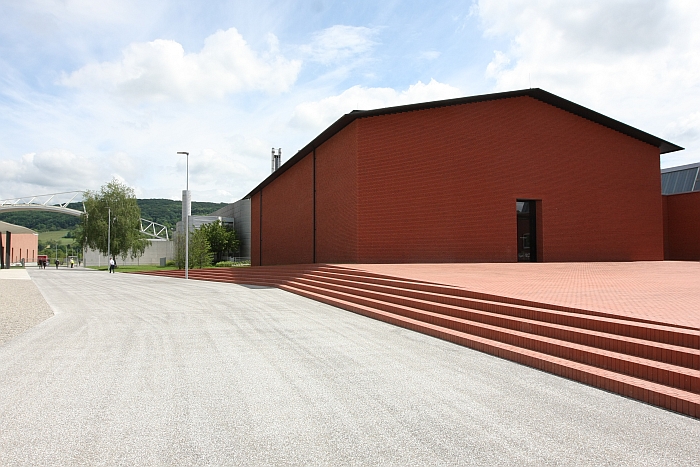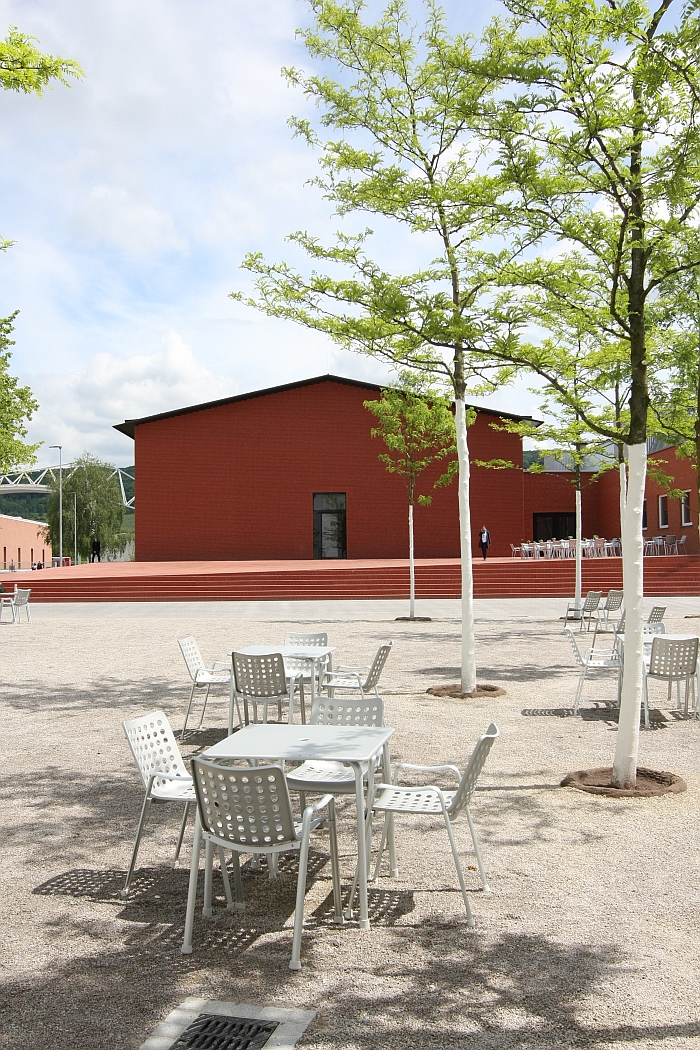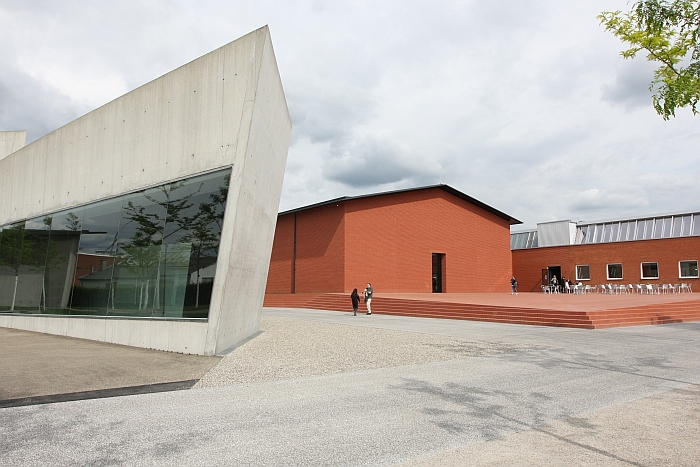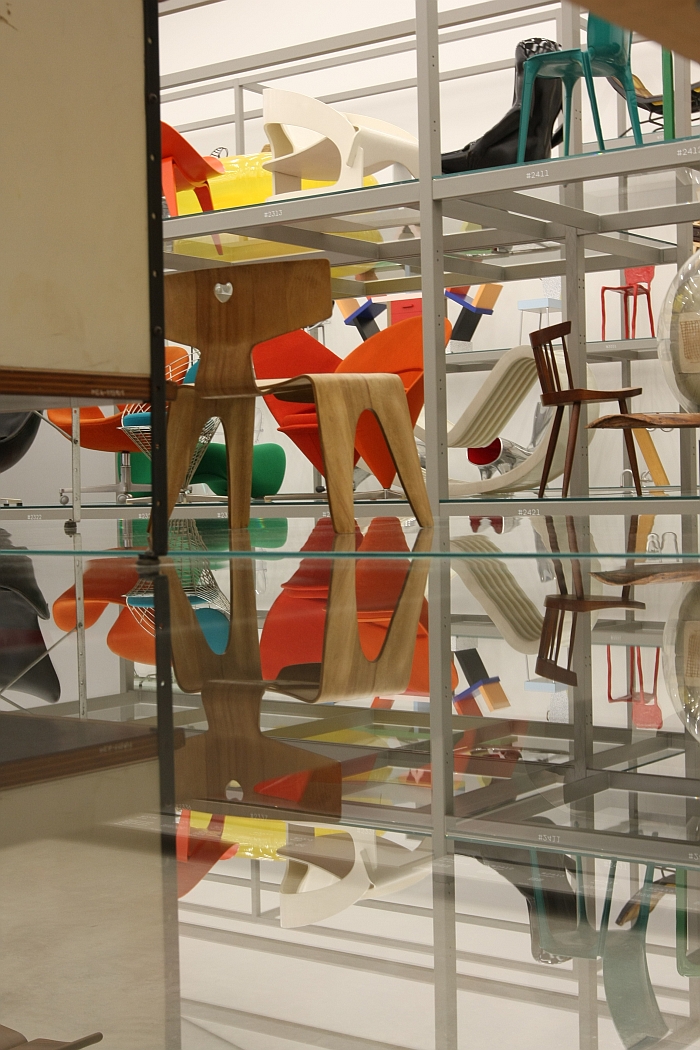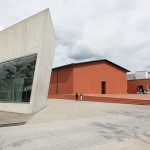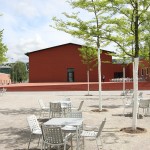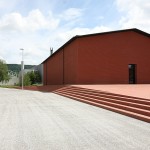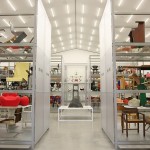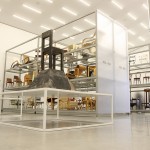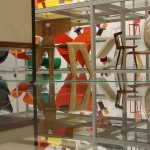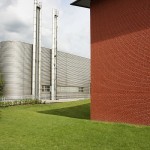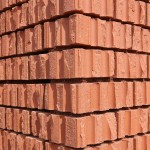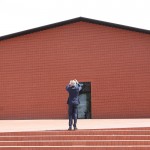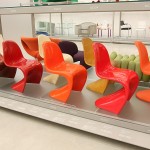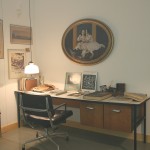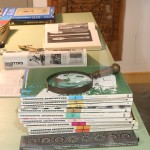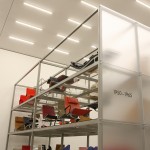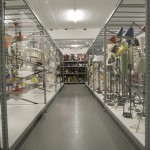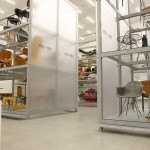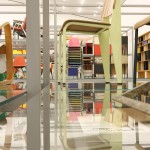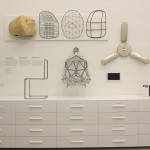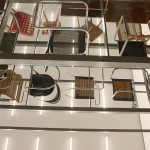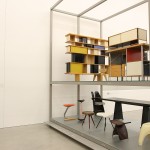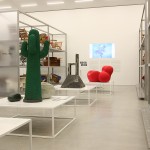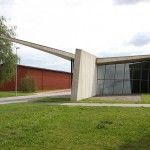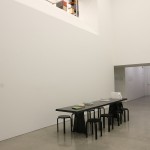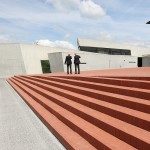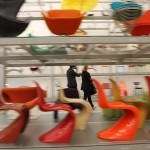Vitra Schaudepot: A New Home for the Vitra Design Museum Collection
With the opening of the Vitra Schaudepot the Vitra Campus has not only grown by a further building, but the Vitra Design Museum has realised a long held dream, that of an exhibition space in which to present their collection in its full extent; or at least in a much fuller extent than has currently been possible.
The Vitra Design Museum collection traces its origins back to 1981 when the then Vitra CEO Rolf Fehlbaum began buying historic examples of works by Charles & Ray Eames, Alvar Aalto and Jean Prouvé for his own interest; and has developed into a collection of some 20,000 objects, including around 7,000 chairs and 1,000 lamps from across genres, generations and geographic divides. And thus into one of the most extensive and important collections of 19th, 20th and 21st century furniture.
Yet was a collection which remained shut away in the cellar of the Vitra Design Museum office building, save for those rare moments when pieces were required for an exhibition.
A state of affairs with which no one was happy.
With the appointment of Marc Zehntner and Mateo Kries as joint directors of the Vitra Design Museum in 2011 a natural moment arose to rethink the museum’s direction, function and presentation concept, and for all to start new projects, one such was the creation of a space for a permanent exhibition of the Vitra Design Museum collection.
Rolf Fehlbaum’s original plan had been to create an underground exhibition space, next to and adjoining the existing storage space, acting as it were as a natural extension of the existing space, just into the public sphere; and he approached Basel’s local global architects Herzog and de Meuron to ask if they would be interested in creating an “entrance” to the new space. At which point one must add that Rolf Fehlbaum has the honesty and humour to admit that he can only approach the likes of Herzog and de Meuron with such ideas because he has known them for so long.
Jacques Herzog and Pierre de Meuron however persuaded Rolf Fehlbaum that it would be more viable to build above ground, especially as a former steel storage building next to the Vitra Design Museum offices was no longer in use and thus offered the perfect, ready-made, solution. Or would have had it not been in such poor structural condition that a renovation was not possible. Consequently Herzog and de Meuron created in its place a building of the same size and volume, and one in which the connection between public display space – the “show” as it were – and the non-public Vitra Design Museum storage – the “depot” – is via an opening in an internal wall which allows the visitor to gaze from above to below.
Kept deliberately closed and windowless, as Mateo Kries is keen to point out, from a conservational perspective in a museum depot every window is one to many, the Schaudepot is constructed from brick – bricks broken by hand on-site and used with the rougher, broken, edges protruding outwards; a device the practice have used in the past and which as Jacques Herzog says creates an effect which is less masonry and more textile. And a feature which in many ways reminds us of the so-called Quetschfuge that Egon Eiermann used to give a physical, 3D, structure to the exterior of his 1937 Wohnhaus Matthies project in Potsdam – and which similarly creates a charming effect with a minimum of fuss, resources and money. And is a feature which may also have something to do with the way the building reflects the light: under the warm June sun we felt as if we were on a set of a Western, the Schaudepot emitting the familiar, strangely welcoming, charm of a slowly disintegrating New Mexico Finca. We suspect that under the grey Weil am Rhein winter sky it will feel very, very different, we’re expecting Scandinavian noir, if every bit as inviting and enticing.
Featuring a gable roof and thus not only resembling the “home” it is but also referencing Herzog and de Meuron’s VitraHaus, the Vitra Schaudepot building is a quietly unassuming beast, easy to miss, yet almost impossible to ignore, very neatly compliments and contradicts the neighbouring Vitra Design Museum offices, Zara Hadid’s Fire Station and Nicholas Grimshaw’s Factory Building, and thus represents an excellent new addition to the Vitra Campus.
In addition the new Schaudepot opens up the Vitra Campus, Rolf Fehlbaum talks of the project giving the Campus a new character. Back in the day we demanded that Rolf Fehlbaum pulled down the fence which surrounds the Vitra Campus and thus make the architectural exhibits more accessible; Vitra haven’t, but in erecting a new fence to more closely constrict the industrial part of the complex they have allowed for direct access to the Fire Station and its new neighbour the Schaudepot…. and finally we understand the Álvaro-Siza-Promenade. When it was opened in 2014 we thought it was nice enough path but… now we understand it, understand the greater thinking behind the project and the way it connects the Campus physically and conceptually, and that without being an overly dominating feature itself. Or as we noted in our original post, “Yes, it’s a path.”
Inside the name is programme, it’s a depot; some 400 furniture objects from over a 100 years of design history arranged chronologically in units three shelves high and which present changes in understandings of aesthetics and form, changes in technology and materials, evolutions in the function and cultural relevance of furniture. It’s mainly chairs – principally we imagine because there is little in our material world which reflects such changes as well and as clearly as the “humble” chair. However tables, shelving and sideboards also feature. Yes, the three high shelving unit concept does make viewing the top row in any sort of detail difficult, when not impossible, and thus as a display concept is probably not ideal; especially for objects which are often as interesting technically as formally, culturally and historically. Spatially however it is important as lower shelves would be lost in the space, and it does in addition mean that the museum can display around a third more objects than would otherwise be the case, something which is important in realising the concept. And allowing the concept to work as well as it does.
It’s a compromise. But then so is life.
The use of glass shelves does however mean that the undersides of those objects on the top shelves are clearly visible, and the underside of a piece of furniture can be every bit as important and interesting as the tops and sides. We endure regular insult and mockery on account of the amount of time we spend looking at the undersides of chairs, especially in restaurants and bars. Hopefully if more people get the chance to do such, and understand the wonders that can await one there, that we will be met with more respect and understanding in the future. The somewhat awkward presentation format is in addition eased by the new digitalisation of the Vitra Design Museum collection, a catalogue which is freely available in the museum either via smartphones, or for hardcore analogists like us via rentable hand held devices, and a catalogue which provides in-depth information on all objects and their creators and thus allows each and every visitor to learn to the depth and breadth they want and need.
Once one gets over the initial “what” as in “where am I?”, “why?”, the presentation does provide for a very well structured, realistic, honest and informative stroll through the history of furniture design, and not just the popular classics but also curiosities, rarities, conceptual dead-ends and objects that will become popular classics. But yes it is a lot of furniture on shelves, and so you do have to be interested in such to get the full benefit of a trip to the Vitra Schaudepot. So, like us. We would quite happily pitch a tent in the Schaudepot and spend our summer holidays there. And we might just. For others it will remain a lot of chairs on shelves, but then again one must assume that those who choose to visit the Vitra Design Museum are interested in such.
Downstairs the “show” becomes “depot” as visitors are allowed an insight, literally, into the depths of the Vitra Design Museum’s collection; glass panels separating you from views along rows of objects divided into four groups: Scandinavian design, Italian design, lighting design and Eames design, the latter being supplemented by a presentation of Charles Eames’, actual, office. In addition the downstairs section features a chance to explore, and for all touch, various types of materials commonly used in furniture production, while upstairs features space for a changing programme of “showcases” highlighting aspects of the museum’s collection and thus the (hi)story of furniture design, the first such showcase focuses on 1960’s Radical Design.
As already stated we’d happily holiday in the Vitra Schaudepot, and have indeed started googling “indoor tents”, for the majority of the population a visit to the Vitra Campus solely to visit the Schaudepot probably makes little sense, for that the subject matter is too specific; however, as an extension to the existing possibilities on the Vitra Campus, and for all as an extension of the exhibitions in the Vitra Design Museum’s Gehry Building, the Vitra Schaudepot is an excellent development as it explains not only the subject matter in hand, but also the Vitra Design Museum, how it works, what it does, how it understands itself, how it understands furniture design and why it wants to transmit all that to as wide a public as possible. Or put another way, helps the Vitra Design Museum in the words of Mateo Kries, “become a much more vibrant location that doesn’t just present exhibitions exploring the most important design themes and topics but much more asks question of the visitors and so becomes more of an experience.”
As such we’d recommend the Combi Ticket. And of course the Vitra Slide.
Full information on the Vitra Schaudepot, including opening times and ticket prices can be found at www.design-museum.de
- The Vitra Fire Station by Zaha Hadid and the Vitra Schaudepot by Herzog & de Meuron
- Vitra Schaudepot by Herzog & de Meuron
- Vitra Schaudepot by Herzog & de Meuron
- The Vitra Schaudepot
- The Vitra Schaudepot
- The Vitra Schaudepot
- Vitra Factory Building by Nicholas Grimshaw and the Vitra Schaudepot by Herzog de Meuron
- Bricks! Broken Bricks!
- We believe it is what is known as an “Architect Selfie” Pierre de Meuron snaps a quick memento
- …. and you thought there was just one Panton Chair…… A collection of different versions from different production periods
- Shrouded by the mists of time… and behind glass. Charles Eames’ desk
- Charles Eames once said “The details are not the details. They make the design.”. And obviously took studying details very seriously…….
- The Vitra Schaudepot
- In the Vitra Schaudepot you can really see the light, thousands of them….
- The Vitra Schaudepot
- Works by, amongst others, Charles & Ray Eames and Jean Prouvé in the Vitra Schaudepot
- Metal furniture solutions by Charles & Ray Eames, Mart Stam, Konstantin Grcic and Oskar Zieta, as seen in the Vitra Schaudepot
- The little regarded undersides of chairs….
- The Vitra Schaudepot
- Radical Design at the Vitra Schaudepot
- The Vitra Fire Station holding a protective arm over the Vitra Schaudepot
- Upstairs Schau, downstairs depot… the Vitra Schaudepot!
- Rolf Fehlbaum & Jacques Herzog admiring Zara Hadid’s Fire Station…..
- The Vitra Schaudepot, a stroll through 100 years of furniture history…..
Tagged with: Basel, Herzog and de Meuron, Schaudepot, Vitra, Vitra Design Museum, Weil am Rhein
